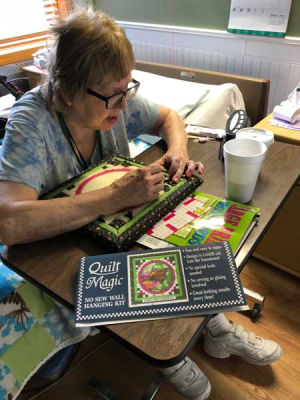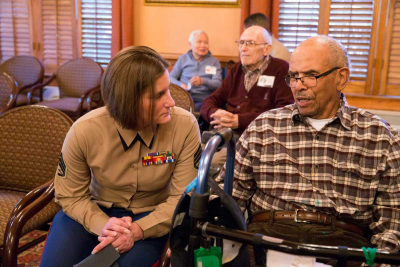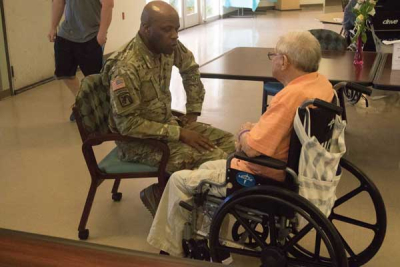America Faces a Tidal Wave of Aging Veterans, Including a 237% Increase in Women Over 65 by 2041
For decades, dawn brought the clarion bugle call of reveille across the lush campus of the Veterans Home of California in Yountville, 60 miles north of San Francisco. The residents, the earliest among them veterans of the Mexican-American war, rose early and dressed in strict accordance with a uniform-like code.
In the late 1800s and early 1900s, the veterans home was a working farm, with chickens, pigs, and a whole herd of cattle, along with apple, peach, and plum orchards. The men spent long days tending to the animals and working the land. The labor was believed to be restorative, giving order and purpose to generations of veterans suffering from what would soon become known as “shell shock.”

Members of the Navy Band Northwest perform at the Veterans Home of California in Yountville, California, in 2018. Photo by Mass Communication Specialist 2nd Class Jacob G. Sisco, courtesy of the U.S. Navy.
Nearly 150 years later, the facility is still in operation. After years of funding and other challenges—one inspection in 2016 found 14 separate fire safety deficiencies—investments in the home have ensured its future continuing to care for California’s veterans. No longer a working farm, the campus is home to more than 1,000 veterans, most of them elderly, with levels of support ranging from independent living to skilled nursing. Today, the campus hums with activity, as construction equipment reshapes the nation’s largest veteran home into one that can effectively and compassionately meet the changing needs of the state’s aging veteran population.
As Vietnam and eventually Gulf War-era veterans grow older, they bring with them new needs, different expectations for care, and greater diversity than the Korean War and World War II veterans who came before them. The Department of Veterans Affairs and veterans organizations across the country are working to care for a new generation of older veterans who tend to have greater expectations for longevity and independence than earlier generations, yet also may struggle with more complex medical conditions.
“We’re kind of compounding multiple variables, in the sense that not only are people living longer, but … many of them survived something that wasn’t survivable,” says Scotte Hartronft, the director of geriatrics and extended care at VA. “A lot of veterans have survived significant injuries over the last couple of conflicts that [they] wouldn’t have survived in previous wars.”
In California, the most populous state in the nation and home to the highest number of veterans, the California Department of Veterans Affairs, known as CalVet, the state’s veterans department, is working to create a modern facility that centers the needs and dignity of older veterans. While the Yountville Veterans Home is unique—as the largest and one of the oldest veterans homes in the nation—across the country, people charged with caring for veterans grapple with the same question that drives the redesign of the facility: How do we best care for those who have served on our behalf as they grow old?
‘The Bulge of the Snake Is Veterans Over 55’
Yountville Veterans Home is one of eight facilities across California that provide long-term care for older and disabled veterans, and sometimes their spouses—part of a legacy that dates back to the decades after the Civil War, when states opened soldiers’ homes to care for the sudden influx of struggling veterans.
Award-Winning Journalism in Your Inbox
With a veteran population of more than 1.6 million in 2020, California is home to a sizable percentage of the nation’s veterans—a population that is steadily growing older.
“A lot of the focus … is on OEF/OIF veterans for obvious reasons, but really, the bulge in the snake, so to speak, of the veteran population in California is certainly over 55,” says Keith Boylan, the deputy secretary for veterans services at CalVet.

The Michigan Veteran Homes, a branch of the Michigan Department of Military and Veterans Affairs provides, provides long-term care and services to enhance the well-being of the residents who live there. Photo by Lt. Col. Kathryn Prater, courtesy of the Michigan National Guard.
Other states see this trend mirrored: Between 2021 and 2041, the number of veterans older than 85 is expected to increase by 31%, according to VA data. In part, that’s because the overall number of veterans nationwide is actually decreasing. During World War II, military service was common; in subsequent wars, the proportion of the population who served has steadily fallen. Between 2000 and 2018, the number of veterans in the country declined by a third—the bulk of Americans who have served in the military served decades ago.
But Vietnam and Gulf War-era veterans represent a different slice of the population than veterans who fought in World War II and Korea. The number of women veterans over the age of 65 is expected to increase by a staggering 237% between 2021 and 2041, according to data from VA. Racial diversity is also increasing, and the geographic distribution of veterans is shifting.
This means veterans’ care must change as well. Women, for example, have a greater life expectancy than men do.
“They tend to live longer, and by living longer, they tend to [need] more assistance with daily living activity needs,” Hartronft says.
Women veterans, as a cohort, will require more support to continue to live independently as they age for longer—a fact compounded by the fact that women, who tend to be informal caregivers to friends and family, often have more difficulty than men in finding their own caregivers when needed.
Other populations—such as veterans who live in rural areas, far from health services, or without housing, or who deal with more complex physical and mental ailments—also require unique approaches to care. And behavioral health support more broadly, especially for veterans who have lived through traumas they might not have survived in earlier conflicts, will be critical in the coming decades.
“We’re trying to always think of what programs can help with the specific individual needs and situation—both the socioeconomic and other situations—because not one thing fits or works for everybody,” Hartronft says.

Air Force Chief Master Sgt. Ben Bush, the North Dakota National Guard State Command Chief, left, gives a gift and visits with a resident at the North Dakota Veterans Home in 2014, in Lisbon, North Dakota. Photo by Senior Master Sgt. David H. Lipp, courtesy of the North Dakota National Guard.
In addition to higher rates of post-traumatic stress and other conditions affecting mental health, veterans are more likely to be exposed to risk factors, such as traumatic brain injuries or toxic exposure, for Alzheimer’s and other dementias. Veterans also have a higher chance of being diagnosed with certain types of cancer, like lung and skin cancer. About 50,000 new cancer cases among veterans are reported annually; that number is expected to rise as veterans age.
“You’re shrinking the population, but the need is still very high,” says Thomas Martin, the head of future operations and planning for CalVet’s veterans homes. “We want to try to do our best job to make sure that we’re helping patch any holes in the safety net.”
‘You Don’t Want to Go From Home to Hospital Bed’
Veterans homes like Yountville actually aren’t very common. There’s a reason for that: long-term in-patient care can cost thousands of dollars per month, according to AARP, and seniors often prefer to live at home, whether for financial, emotional, or other reasons. As baby boomers age, the focus of elder care has increasingly shifted from live-in facilities to aging-in-place services, allowing people to stay in their homes for as long as possible, while increasing support and services as needed. Keeping people at home longer reduces hospital visits, and recovering from some medical procedures at home leads to fewer inpatient complications and brings down the cost of care.
“When it comes to aging in place specifically, we’ve had one of the largest expansions of home care in the VA,” Hartronft says.
Within the next two years, every VA medical center will offer veteran-directed care, a popular program that provides qualified veterans with a stipend to hire local caregivers to assist them with daily living or even companionship. VA is expanding home-based primary care—which provides health care to veterans at home, many of whom are housebound—to 75 new sites, as well as expanding its Medical Foster Care program, which allows some veterans to live in a private home with a caregiver, rather than in a nursing home. They’re also piloting a program using predictive analytics to help determine which veterans are at the highest risk of nursing home care in the coming years, to connect them with preventive services.

Marine Corps Staff Sgt. Amanda J. Eason, a planner at Marine Corps Base Quantico, speaks with a resident at the Heatherwood Retirement Home during a Veterans Day visit in Burke, Virginia, in 2016. The annual trip by Marines to the retirement home includes honoring each veteran present, a speech from the battalion commander, and a traditional cake-cutting ceremony in celebration of the Marine Corps’ birthday. Photo by Staff Sgt. Sarah R. Hickory, courtesy of the U.S. Marine Corps.
“Our biggest goal is really advertising the aging-in-place services so that people think of them proactively and don’t only think of them during a crisis,” Hartronft says.
But for some veterans, continuing to live at home as they grow older isn’t an option—or they prefer to live with people who understand their history of service.
“They wanted to be in an environment of veterans, and surrounded by veterans,” says Martin of residents of California’s veterans homes.
The Yountville renovation—designed by the architecture firm CannonDesign, and slated to be completed early next year—aims to set a standard for caring for a diverse population of veterans who want to or need to live in a care facility. The project replaces a 90-year-old hospital building with a state-of-the-art skilled nursing facility and memory care center. The same principles that support the idea of aging in place—dignity and independence—guide its design.
“Most of these people have just come from home,” says David Hunt, who leads CannonDesign’s health practice in Southern California. “You don’t want to go from home to hospital bed.”
Instead, the project works to make veterans feel as much at home as possible. Visually distinct “neighborhoods,” each with their own small shared dining and living areas, make up the facility. Designers avoided the glaring fluorescence of a hospital ward, instead using light fixtures that build on research into how the eye changes as it ages, as well as what makes a space feel comforting. The same goes for furniture and decor.
The more a long-term care facility feels like home, the happier residents are—and the better their health outcomes are, research shows.

Army Lt. Col. James Key speaks with an Air Force veteran from the Veterans Home in Barstow, California, during a Veterans Home volunteer event in 2019. Photo by Pvt. James Newsome, courtesy of the U.S. Army.
“They have symptoms of less pain, they eat better,” Hunt says. “So it’s not just to make it homey. It’s also proven to be medically more efficient.”
The design considerations promote independence, even among veterans dealing with cognitive impairment or dementia. Visual cues, such as photo murals of “amber waves of grain,” help orient residents who can no longer read, and outdoor walking paths enclosed in a garden allow dementia patients to wander without getting lost.
“You want to maximize their ability to be independent, to be able to walk around without having to keep a close eye on them,” Martin says. “You want to make sure that its environment is going to be safe and welcoming.”
Ultimately, many experts say, what matters is thinking through care in a “veteran-centric” way—buying into the idea that honoring veterans as they age means taking the time to understand who they are and what they want, and then incorporating that into real-world care considerations.
Take scooters, for example. When designers from CannonDesign visited the Yountville campus, they realized how many residents got around on motorized scooters.
“They’ve got this gorgeous 600-acre-plus community, and those scooters allow them to get around a bit,” says Margi Kaminski, a co-director of health interiors at CannonDesign. “I’m not sure I would call them a status symbol, but they definitely are a big thing.”
Our Journalism Depends on Your Support
That human experience—the ease of mobility around the sunshine-soaked campus, the social capital that comes with being one of the scootering set—translated into real-world design considerations. Architects ensured that rooms were big enough for veterans to about-face their scooters with a three-point turn. There’s even a repair shop on the first floor.
“It’s not just about having the bed,” Martin says. “It’s about having the right environment.”
This War Horse feature was reported by Sonner Kehrt, edited by Kelly Kennedy, fact-checked by Jess Rohan, and copy-edited by Mitchell Hansen-Dewar. Headlines are by Abbie Bennett.





Comments are closed.